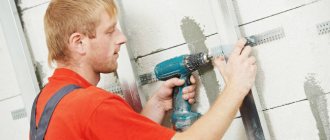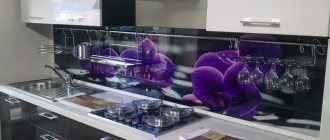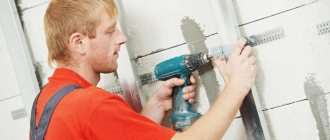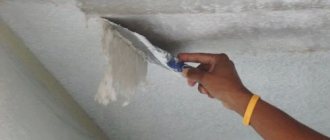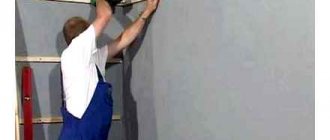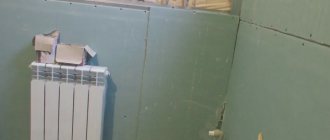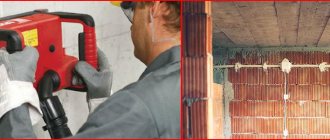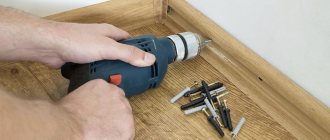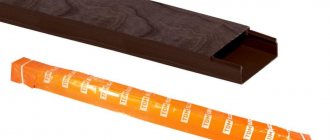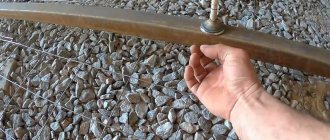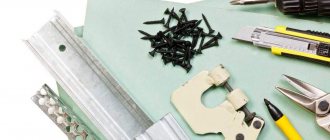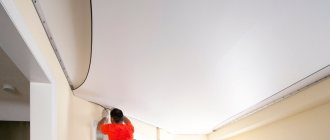Dowel-nails
Installation of a frame for plasterboard begins with fastening the hangers, and then the guide profile to the floor and ceiling. Most often, hangers and profiles are attached to a concrete or brick wall. Less often - to a wooden base, even less often - to plaster. For wood and plaster you need self-tapping screws, we will return to them a little later; for concrete and brick you need dowel-nails. They come in two types and both are suitable for fastening frame parts to a solid base.
Dowel-nails with thread. The simplest and most common option for fastening profiles. To use it, it is enough to have a hammer drill with different modes; in some cases, you can get by with a simple drill or even a screwdriver. Externally, the nails look like a self-tapping screw, but they are exactly a nail; you need to hammer it into the dowel with a hammer and only at the end can you tighten it with a screwdriver. Pay attention to the thread, it is not symmetrical and is shifted towards the head, so it is driven in easily. If necessary, the nail can be unscrewed.
Dowel-nails with thread for fastening plasterboard profiles to walls
Dowel-nails are needed with a size of 6x40mm or 6x60mm, this is quite enough for strong fastening of the guide profiles. It is better to use only on walls and floors. If the holes in the ceiling are loose and the dowel-nails dangle in them, then it would be safer to choose another fastener for the ceiling - a wedge anchor or a dowel-nail for a pneumatic gun.
Dowel nails for a mounting gun. Expensive, but very durable fastening option. For the ceiling, you can use short 18mm dowel nails. Despite the small size, the connection strength is very high.
Cassette with dowel-nails for construction and assembly gun
When driving a nail, it is practically soldered to the concrete due to the high temperature. Such dowel-nails are driven in with a special pneumatic gun. Not every home has such a tool, but the speed of operation and durability are at a high level.
Considering the high cost of the air gun and the dowel-nails for it, the popularity of such fasteners, even among construction crews, is low. Efficiency is excellent, but too expensive.
Profile material fastener
This type of fastening is very common, since in this way it is possible to assemble structures of any complexity both on the wall and on the ceiling. Knowing the main points of the work, their basics, the ability to complete the work independently will not be difficult for even the most inexperienced owner.
Fastening for a profile for plasterboard can be divided into several main stages of work:
- Fastening guide elements to the surface.
- Connecting profiles to each other.
- Attaching the supporting profile to the wall or ceiling.
- The final stage is attaching the drywall.
Self-tapping screws
To assemble a frame from profiles, you will definitely need self-tapping screws - for wood, if the frame guides are attached to a wooden surface, and for metal, to fasten different types of profiles together.
Self-tapping screws for fastening the profile frame. Two types of self-tapping screws are excellent for fastening the profile to each other - with a cylindrical head and with a press washer. All threads are small, for metal.
Self-tapping screws with cylindrical head
Self-tapping screws with press washer
These screws can have different coatings, tips, and sizes. Which one you choose is up to you, the difference between them is not fundamental. To assemble the frame, metal screws with a diameter of 3.5 mm and a length of 9.5 mm are used.
Self-tapping screws for fastening plasterboard sheets. To install gypsum board sheets to the frame, you will need self-tapping screws, always with a countersunk head. For a metal frame - fine thread, for a wooden frame - large.
Self-tapping screws for fastening drywall to the frame
The tip can be sharp or with a drill. A self-tapping screw with a drill is used for metal frames with a thickness of more than 0.7 mm. This way the profile does not deform and it is easier to screw in the self-tapping screw.
Fastening additional elements to the drywall surface
If you need to hang a lamp on a plasterboard ceiling, attach a TV, a mirror or something else to a plasterboard wall, then you cannot do without special fasteners. You should not hope that a regular self-tapping screw screwed into the gypsum board will be able to provide reliable fastening.
To solve this problem, you can use the following fasteners:
- "Butterfly". A plastic, or less often metal, dowel inserted into a drilled hole. When the screw is screwed in, its wings, which are located behind the surface of the drywall, open and securely fix the fastener.
- Driva type dowels. They do not require pre-drilling, since this part has small drills at the end. A dowel made of plastic or metal is screwed into the gypsum board, where it is held in place by a special thread with a rare pitch. The screw screwed into it serves to fix the attached element.
- The “Molly” type dowel is somewhat reminiscent of a “butterfly”, but has a more complex structure and is capable of supporting more significant weight. It is also inserted into a pre-drilled hole, after which the special “hangers” that provide fixation are opened by screwing in the bolt. Subsequently, the bolt is unscrewed, and in its place you can place an eye, hook or screw necessary for mounting the attached product.
Rivets
An alternative to self-tapping screws when installing a frame from profiles can be rivets.
Rivets and riveter
The method is excellent, the rivets hold well, nothing falls off, the head has minimal convexity. But this connection method is used much less frequently; it requires additional tools and more time.
Cutter
A profile cutter is not a fastener, it is a tool. The fastener in this case is the profile itself. The cutter pierces both profiles at the junction, cutting out the retaining whiskers on the reverse side.
Profile cutter for drywall
The cutter has a lot of advantages over self-tapping screws and rivets - there are no costs for fasteners, there are no convex surfaces, the connection occurs instantly, and its strength is fully consistent with the design.
68 tools for working with drywall
Read
Conclusion
If you know your way around fasteners well, you will be able to carry out the work very efficiently and reliably. The video in this article will help you understand the issue even better, and if you still have questions, write them in the comments under the review, we will sort them out together.
Did you like the article? Subscribe to our Yandex.Zen channel
September 28, 2016
Plasterboard systems, Fasteners, hardware, meshes and membranes
If you want to express gratitude, add a clarification or objection, or ask the author something, add a comment or say thank you!
Anchors
A variety of anchors will come to your aid when the walls lack strength, they crumble and crumble when drilled. Or when you need to hang something very heavy on the wall.
Wedge anchor. Not to be confused with a wedge anchor, this is a different type of fastener and is not suitable for a profile. And the wedge anchor, which is shown in the photo, is well suited for attaching pendants to the ceiling.
Wedge anchor for fastening plasterboard guide profile
Most often, threaded dowel-nails are used for ceilings, but they may not be reliable in a vertical position due to the poor strength of the ceiling. The dowel-nail can dangle, and with it the entire frame.
The wedge anchor holds up perfectly even in loose concrete; its design tightly wedges the mechanism so that pulling it back will be a difficult task. In addition, the wedge anchor meets fire safety requirements, since it has no plastic components and is made entirely of metal. For this type of fastener you will need a hammer and hammer.
Anchor bolt. Or a wedge anchor. Anchor bolts are not needed to fasten the frame and plasterboard sheets, but they are perfect for hanging very heavy objects on a plasterboard wall. Boiler, bracket for a large TV, wall cabinet.
Anchor bolt for heavy objects
The anchor bolt is not mounted into the drywall or frame, but into the main wall. It is important to understand that the length of the anchor bolt must be chosen so that most of it is in the main wall and only a small piece of it sticks out from the plasterboard wall. This is the only way it will withstand heavy loads and not break.
The anchor is foldable. Attaches directly to a sheet of drywall rather than to a concrete wall. Folding supports increase the strength of the fastener.
Folding Drywall Anchors
A folding anchor can have different types of pins - a hook, a ring or a screw. The supports can be either folding or tilting. Folding supports are equipped with springs, tilting ones are not.
Folding anchors are useful for not very heavy interior items - shelves, clocks, paintings, mirrors. You can use them to hang a chandelier on the ceiling.
Anchor screws
Anchor screws, or anchors, are great in two situations:
- Plasterboard finishing was done using mounting adhesive, and the distance to the load-bearing walls was minimal.
- The gypsum board sheathing is made on a frame, but is located at a short distance from the main wall.
In this case, you will need a hammer drill or drill and anchor screws. The future location of the item is marked on the wall. Holes are punched according to the markings and anchors are driven in. Subsequent tightening will secure the anchor firmly in the wall.
The main subtlety of this fastening is that the hole must be punched according to the diameter of the anchor. If it is smaller, the fasteners simply will not fit, and a large diameter will not provide reliable fastening, and there will be backlash.
But the most problematic question is how to attach a shelf to a plasterboard wall if the load-bearing surface is at a distance of 100 millimeters or more.
Dowels
Dowel butterfly. Simple and convenient fasteners for small interior items hung on a plasterboard wall. It got its name because of its shape. Originally sold flat. During installation, the self-tapping screw is screwed in and folds the dowel, increasing the support area and forming a butterfly shape.
Drywall fasteners butterfly dowel
It is mounted in a sheet of plasterboard in a vertical position. To prevent turning, it has special ribs. Requires sufficient space inside the wall. I wrote detailed instructions in an article about the correct installation of a butterfly dowel.
Dowel Molly. Structurally similar to the butterfly dowel, but made of metal. The dowel itself is always the same, but the pin can have different options - a ring, a hook, an angle and a screw.
Types of Molly dowels
When the threaded element is tightened, the body of the dowel turns into a kind of umbrella, resting against the sheet of drywall on the back side.
An example of fastening with a Molly dowel
This increases the support area of the fastener and its reliability. To prevent rotation, the dowel is equipped with spikes.
Dowel Driva. It has both an external conical thread and an internal self-tapping thread. It comes in both metal and plastic.
Types of Driva dowels
Using a sharp drill, it bites into a sheet of drywall and is fixed in it using an external thread. The dowel is screwed in using a screwdriver.
An example of fastening with a Driva dowel
After this, you can screw in the self-tapping screw and hang light objects.
Doubel Hartmut. Knauf fasteners. The threaded element is only a screw.
Doubel Hartmut
The metal support is folded along the plastic guides, inserted into the hole in the drywall, aligned parallel to the wall and secured with a plastic clamp. The extra mustache just breaks off.
How to attach heavy objects to drywall in a void
Often, plasterboard structures may be too far from the load-bearing wall, or the partition may be completely framed. In this case, anchor screws will not work, much less use standard plastic dowels. The anchors, due to the lack of support, will not provide fastening and will create a large load on the wall with its further destruction. And the plastic one will fall out immediately. What to do in this case, how to ensure that heavy objects are fastened to drywall in an almost empty space.
Methods and procedures for covering a balcony with plasterboard
You can use special fasteners for gypsum boards specifically for problematic fastenings of heavy objects:
- Mounting on brackets or hooks.
- Four-segment dowel.
- Butterfly dowel.
- "Driva".
- Dowel type "umbrella".
- Dowel moth (Molly).
Of course, as an option, you can use a method such as attaching it to frame posts. To do this, you need to know where they are and screw the screws into the profile. But this way you can hang objects of relatively small area and weight, for example a painting.
Liquid Nails
The strange name hides ordinary construction adhesive. Glue has little in common with nails and screws, but, nevertheless, it is also present in our selection of fasteners for a reason.
Liquid Nails
Liquid nails can be used to glue various materials, including drywall. To do this, you do not need to build a frame from a profile; the sheets are glued directly to the wall.
Liquid nails are supplied in tubes and are applied using a special gun.
Required tools and materials
If there is something eternal in the world, it is a basic set of tools, which is necessary in order to be able to perform all the required manipulations with the material.
- knife;
- level;
- plumb line;
- painting cord;
- roulette;
- pencil;
- hammer;
- putty knife;
- container for adhesive composition;
- screwdriver;
- roller;
- plane.
And, in fact, materials, both basic and consumables, which sometimes we don’t pay attention to at all and completely in vain - because without them nothing will work.
- gypsum board sheets (if you plan to install them in a room with high humidity, choose green or blue sheets - they are marked as “moisture resistant”);
- profiles or wooden slats (if you plan to create a frame);
- self-tapping screws;
- nails;
- cement or gypsum based glue, liquid nails;
- primer and putty.
The final choice of materials depends on which installation method you choose:
- with the creation of a frame (sheathing);
- directly on the wall.
Profile connectors
In addition to self-tapping screws, rivets, dowel-nails, profiles are joined together using special connectors.
Crabs. Create X-shaped or T-shaped connections of profiles.
Crab profile connector
The crabs have special latches for the profile size. For greater reliability of the connection, it is better to fasten the crab and profiles with self-tapping screws; the crabs also have holes for them.
Extension cords. If you need to increase the profile, this can be easily done using an extension cord.
Profile extension
You join two profiles through an extension and secure them with four self-tapping screws. The connection is ready.
Two-level connector. You will need it if you are planning a two-level frame made of profiles. Its function is to create X-shaped connections at a 90 degree angle.
Two-level profile connector
It goes on sale in unfolded form and, when assembled, is bent into a U-shaped element.
Side connector. Forms a T-shaped profile connection.
Side profile connector
If a side connector is not available for sale, you can use a crab by cutting off one extra side.
Corner connector. Fixes the ends of the profile at an angle of 90 degrees.
Corner profile connector
Supplied flat. Before assembling the frame, the corner is bent at the perforations. Attached to the profile using self-tapping screws.
